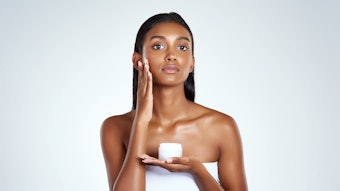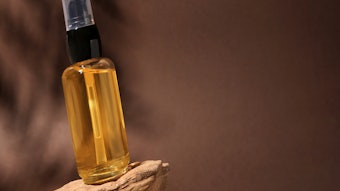- Biomimetics are scientifically developed ingredients that are inspired by nature.
- New developments in technology are enabling the creation of new stories—including stories of better efficacy, better safety and better compatibility.
- Biomimetics can be part of a unique brand story—one that is easy and straightforward for consumers to understand.
Science and nature—two seemingly opposite forces that consumers are seeking more and more in beauty products. However, in biomimetic ingredients, these two ends of the spectrum come together to help create effective, consumer-friendly products.
What Are Biomimetics?
How can nature and science come together for such ingredients? Through the development of ingredients created to mimic a specific bio function in the body.
Fabrice Lefevre, scientific marketing manager with Induchem, explains, “To create a biomimetic molecule, you get inspired by the analysis of natural/biological processes. The concept of biomimetic has moved [to the beauty industry] from the pharma industry, in which researchers are constantly analyzing natural pathways to understand how they can design or identify a molecule that will replace, inhibit or stimulate the action of a therapeutic target in our body. As the global cosmetic industry is moving toward pharma-like behavior to ensure better safety and efficacy of skin care products, the concept of biomimetism has been rapidly adopted.”
Essentially, these scientifically developed ingredients are inspired by nature. Cherylanne DeVita, PhD, president and CEO of beauty brand DeVita International, Inc., says, “Learning from nature will give us important inspiration to develop new techniques and methodologies specific to our industry, leading to advanced moisturization methods, uptake of peptides and bio-catalysts for cosmetic-functional hybrids.” And while DeVita seeks ingredients that are plant-based, as opposed to synthetically manufactured, the ability to develop these types of beauty ingredients in labs is picking up steam as well.
Describing how a biomimetic active functions, Lefevre says, “A biomimetic molecule is a copy of a biological key that your body is normally producing to activate some responses. If your skin has lost the initial key for any reason—aging, stress and so on—the biomimetic molecule will replace the lost key and activate the right responses again. This approach is very clever and highly potent, but it requires a lot of scientific research to identity which ‘key’ should be copied and how to use it. Finally, advanced synthesis processes like biotechnology ones are required to synthesize these biomimetic compounds.”
Biomimetics in Beauty
While these scientific feats are impressive, how exactly do they fit into beauty? As Christophe Toumit, marketing manager, personal care brands, for Croda Inc., and Denise Gabriele, vice president, sales and marketing, for Sederma, Inc., note, “Due to the recent advances in technology and test methods today, biomimetic ingredients are still novel in the beauty industry. And the new developments in technology are enabling the creation of new stories.”
According to Lefevre, these new stories can include stories of better efficacy, better safety and better compatibility. Addressing efficacy, he says, “A biomimetic compound is directly targeting the right pathway, and is expected to have the same efficacy as the natural compound it mimics,” while for safety, he notes, “The biomimetic should by definition have the same safety as the initial molecule from your skin,” and for compatibility, “Biomimetics are usually efficient at low dosage and don’t activate side effects if they are used in the right conditions.”
Lefevre goes on to say, “The fields of applications are very diversified: peptides to reactivate cellular division; sugars to reactivate the synthesis of extracellular polymers; amino acids to improve skin hydration, biomimetic natural moisturizing factor; lipids to repair the skin barrier and the cell membranes.”
In terms that translate to consumer stories, Elena Cañadas, marketing director, and Cristina Davi, product manager coordinator for Lipotec, comment, “The use of biomimetic actives is seen primarily in cosmeceutical skin care launches, and this concept has been widely extended from prestige brands to masstige brands. Such active ingredients have excellent results in correcting aging signs and preventing premature aging—or, as is trendy nowadays, helping consumers [look] nicer, not younger.”
So, for example, in Lipotec’s product portfolio, biomimetic ingredients include its Serilesince peptide, which strengthens the dermo-epidermal junction in skin; the Decorinyl peptide, which mimics the sequences of decorin that specifically bind to collagen fibrils regulating fibrillogenesis, improving skin suppleness; the Hyadisine marine ingredient, a biomimetic of hyaluronic acid that helps confer benefits such as moisturization and wrinkle reduction to the skin; and the Lipochroman synthetic molecule, which could be considered a biomimetic ingredient as its structure is similar to γ-tocopherol in the skin, offering the same antioxidant effect.
Toumit and Gabriele share, “One of the most familiar and successful biomimetic ingredients—or family of biomimetic ingredients—is lanolin and its derivatives, which Croda has offered as part of its product portfolio for decades. Lanolin, such as Pharmalan USP, improves the natural moisturization of the skin by mimicking the intercellular lipids of the epidermis. You can find lanolin in many applications, including daily moisturizers, anti-aging products, intensive skin care, lip care, baby care, hair conditioning and topical pharmaceuticals.”
Clearly, a key beauty segment for biomimetic ingredients is skin care, with other examples from Croda and Sederma being Revitelix, a plant derived source of omega 3, 6 and 9 that is able to rejuvenate and revitalize skin; Venuceane SP, obtained by fermentation of a bacterium and used to reinforce the cutaneous barrier, improve skin moisturization and prevent of the visible signs of photo-aging; and Resistem, a plant extract obtained by stem cell culture of Globularia cordifolia that helps the skin build its own anti-aging defense system; while other beauty ingredient suppliers offer ingredients such as Collaxyl IS biofunctional, an anti-aging peptide that helps reduce the length and depth of wrinkles using a sequence comparable to sequences found in human collagen XVII—a collagen specific to the dermo-epidermal junction—which was developed by the Vincience skin care team at Ashland.
But biomimetics aren’t limited to skin care. According to Toumit and Gabriele, other examples of biomimetic ingredients from Croda and Sederma’s product portfolios include Kereamimic 2.0, which provides targeted repair to damaged areas of the hair’s surface; and Cutissential, which replenishes the primary lipid (18-MEA) of the surface of healthy hair.
Discovering these biomimetics can be as inventive as using them too. Lefevre shares a story of one of Induchem’s ingredient developments. “A few years ago, we were looking at very specific skin receptors, and demonstrated that these receptors—called delta-opioid receptors—control the differentiation of skin cells. Upon aging, various biological processes deactivate these receptors, and this is one of the reasons why our skin shows visible signs of aging. Our body produces some peptides that can protect these receptors, but such molecules cannot be extracted—nor directly used. Based on their chemical structure, we screened different natural sources until we identified one peptide able to reactivate these receptors as natural ones do in our skin,” he explains. “When you apply this biomimetic peptide on skin, the receptors are protected from being deactivated, and skin cells reactivate their division, leading to a visible skin rejuvenation. Similar chemical structure, same biological activity—this peptide called Rubixyl is a perfect example of a biomimetic active,” Lefevre says.
Relating Biomimetics to Consumers
The opportunities in product development biomimetics offer are certainly exciting, but beauty brands also have know how to talk to their customers about how these ingredients are helping to better their beauty products.
As Lipotec’s Cañadas and Davi explain, “Consumers know more every day, and they are more aware of the cosmetics they are using. They look for fast and good results, quick and easy solutions that align with their busy lifestyles—therefore, multifunctional products become highly relevant. They are also interested in innovation, novelty, value for money and efficacy assurance. Biomimetic actives fulfill such desires, as they provide good [efficacious] results.”
In marketing, it’s knowing enough about the products and their formulations to make your brand stand out. “Brands have to find short cuts—unique stories—that can give both a clear and understandable insight to the end consumer and create or facilitate an emotional bond between the end consumer and the brand and its products,” say Toumit and Gabriele. “Biomimetic products offer solutions for both of these ideas.”
Because, as Lefevre comments, “In terms of consumer perception, the notion of biomimetic is also very easy to understand and straightforward. It’s rational, simple and highly scientific, too.” The twofold attack of biomimetics—that they are efficacious and a novel combination of science and nature—offer a strong story for skin care, hair care, anti-aging and cosmeceutical products, and more. “As these biomimetic ingredients are delivering substantiated benefits and parallel consumer desires for more product efficacy, these will help to reinforce the brand and product promises of benefits while taking the end consumers’ quest for efficiency to the next level,” say Toumit and Gabriele.
What’s Next
Where will biomimetic beauty ingredients go next? Lefevre says, “I’m a strong believer in this kind of ingredients. This is the reason why we concentrate our research on the characterization of highly specific biological targets, to identify which biomimetic molecule could be developed to reverse aging processes by acting on these targets. Innovation cannot only come from the molecule itself: it must also come from the target on which the biomimetic will act.”
Additionally, he notes, “The notion of biomimetic [also] has been extended to other notions: biosimilars and bioequivalents. Biomimetics give the same results in terms of biological action than a natural molecule. Biosimilars are molecules that have a chemical structure very close to a natural molecule, and give identical results. Bioequivalents are molecules that have the same structure as a natural one, and give the same results.”
Perhaps biosimilars and bioequivalents are ingredients to look toward in the future of beauty product development. However, there is no question that biomimetic ingredients are helping bring a new dimension to beauty products today.
As Toumit and Gabriele say, “These biomimetic ingredients represent opportunities with upside potential, offering both story and functionality.”










